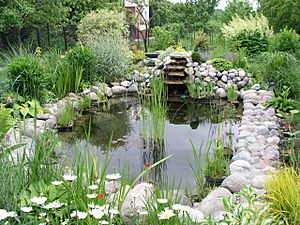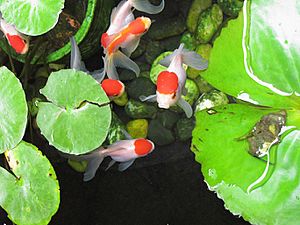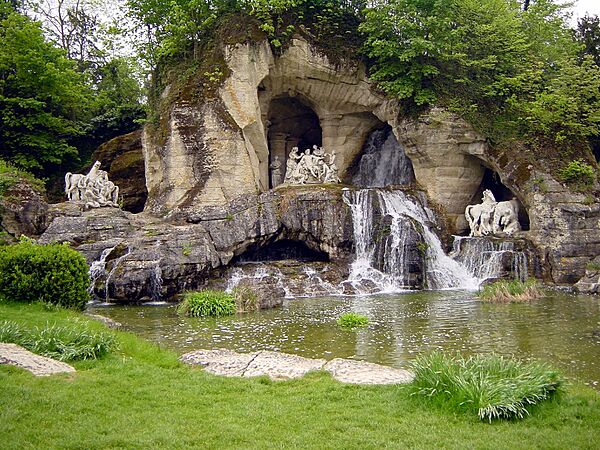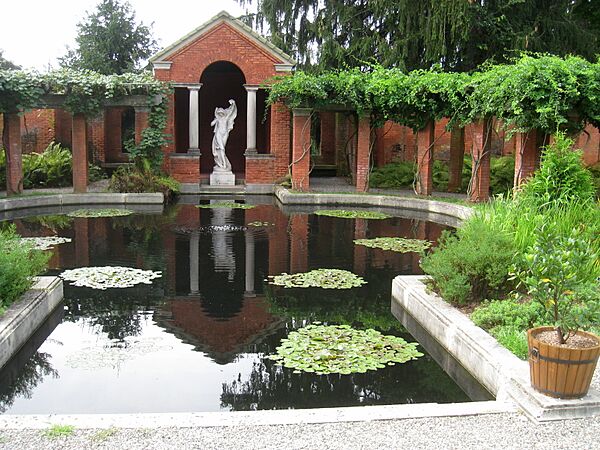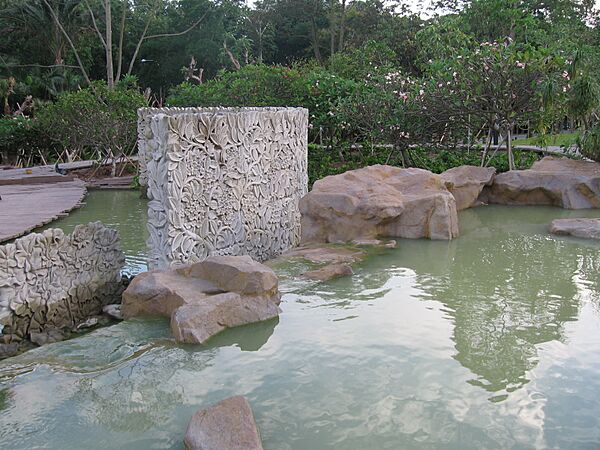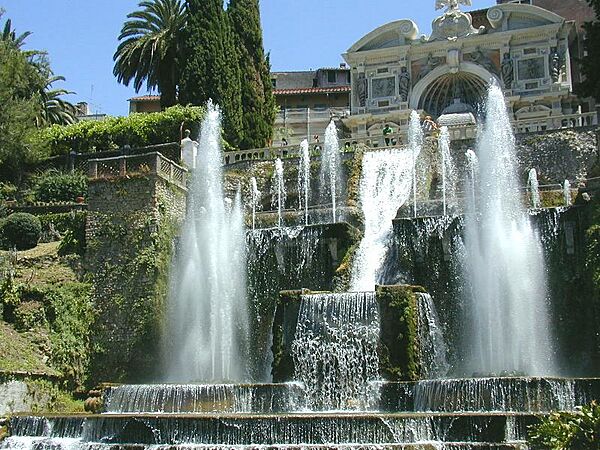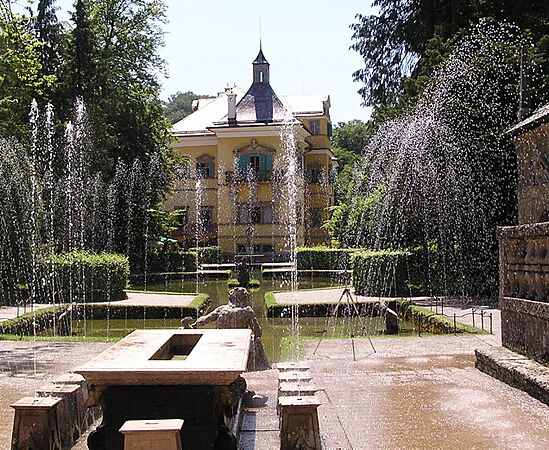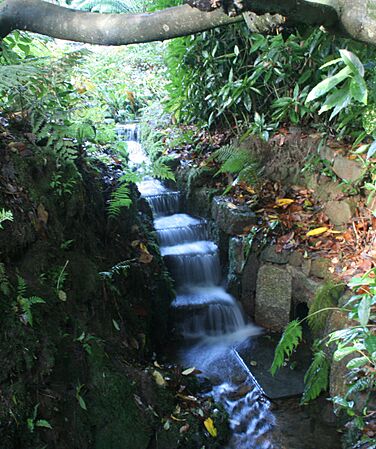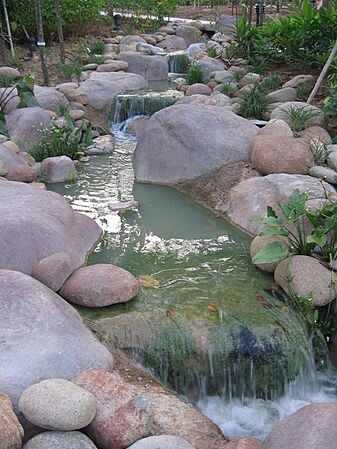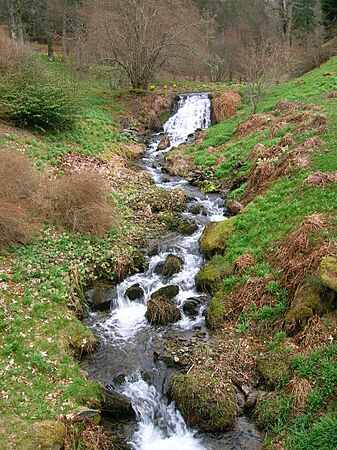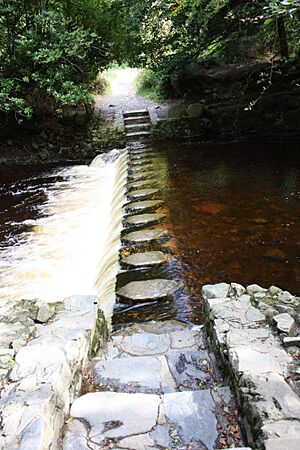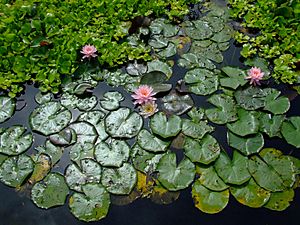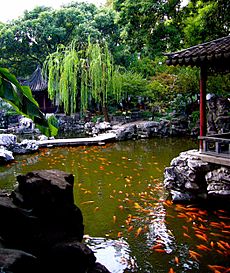Water garden facts for kids
A water garden (also called an aquatic garden) is a special type of garden. It's a place where water is the main focus. These gardens often have ponds, streams, or waterfalls. They are designed to grow plants that love water. Sometimes, water gardens also have waterfowl (like ducks) or pretty ornamental fish. If fish are the main focus, it might be called a fish pond. Water gardens can be big or small, and they come in many different styles.
Water gardening means growing plants that live in lakes, rivers, and ponds. Many water gardens are not very deep, maybe less than 20 inches (50 cm). This is because most water plants need a certain water depth to grow well. You can even plant them in special baskets that sit on the bottom. A water garden might also have a bog garden. This is a wet area for plants that like very soggy soil. Sometimes, people create water gardens just to grow specific aquatic plants, like beautiful water lilies.
Contents
History of Water Gardens
Water gardens and other water features have been part of gardens for a very long time. They were popular in ancient Persian gardens and Chinese gardens. For example, a book from around 304 AD talks about growing Chinese spinach on floating gardens. Water features have been important in gardens throughout history and in many cultures.
For a long time, water in gardens was not reused. It flowed from rivers and springs into the garden. Then it would flow out into farm fields or natural streams. This changed when modern water pumps were invented during the industrial age. Historically, water features helped grow plants and fish. This was for both food and for making gardens look beautiful.
What Makes a Water Garden Special?
When the plants and animals in a water garden are balanced, they create a healthy aquatic ecosystem. This helps keep the water clean and clear. Many things can be added to a water garden to make it more interesting. These include fountains, statues, artificial waterfalls, and big boulders. You can also add underwater lighting, special linings, and different types of plants. All these elements help the water garden fit in with the surrounding landscape.
Types of Water Features
In landscape architecture and garden design, a water feature is something that uses water. It can be a fountain, a pool, a pond, a small stream (rill), or a artificial waterfall. Modern water features usually recycle their water. This means they don't need new water to be constantly added. The water is pumped from a pond or a hidden tank (called a sump) and then flows back into the feature.
-
The Bosquet of the baths of Apollo in the gardens of Versailles
-
The pond at the Vanderbilt Mansion
Water Follies
In the 1500s in Europe, people became very interested in old Greek ideas. They studied the works of Hero of Alexandria, who wrote about how water and air could be used to make things move. He created devices like temple doors that opened by themselves. He also made mechanical birds that sang using steam. These ideas inspired palaces in Europe to build similar clever devices. They wanted to impress people.
In Italy, some royal families built huge water gardens with moving parts. A famous example is the Villa d'Este in Tivoli, built in 1550 AD. It had many fountains and caves (grottoes) on a hillside. Some of these had water-powered figures that moved or shot out water. This idea became popular across Europe. The Hellbrunn Palace in Austria had a water garden with many water-powered human and animal figures. It also had "folly" fountains that would spray visitors by surprise!
Stream Gardens
If you have a stream in your garden, you can place rocks in the water's path. This creates small patterns, fast-moving water (rapids), and tiny waterfalls. The rocks make the water splash and bubble. This creates nice sounds and small areas for plants, fish, and wildlife to live. Well-placed rocks also add oxygen to the water. More bubbles mean more dissolved oxygen, which is good for fish and prevents the water from becoming unhealthy.
Aquatic Plants (Flora)

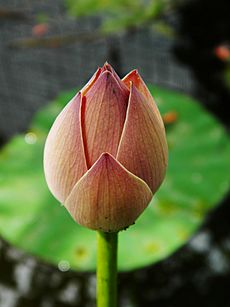
Water garden plants are put into three main groups: submerged, marginal, and floating.
- Submerged plants live mostly under the water. Some of their leaves or flowers might reach the surface, like water lilies. These plants are usually placed 1 to 2 feet (30 to 60 cm) below the water. Some are called "oxygenators" because they add oxygen to the water for fish.
- Examples: Water lily, Hornwort (Ceratophyllum demersum), Featherfoil (Hottonia palustris).
- Marginal plants have their roots under the water, but most of the plant grows above the surface. They are usually placed so the top of their pot is just at or below the water level.
- Examples: Iris or flag (Iris spp.), Bulrush (Scirpus lacustris), Cattail (Typha latifolia), Lotus (Nelumbo spp.).
- Floating plants are not attached to the soil at all. They float freely on the water's surface. In water gardens, they are often used to create shade. This helps reduce the growth of algae. These plants often grow and multiply very quickly.
- Examples: Mosquito ferns (Azolla spp.), Water lettuce (Pistia stratiotes), Water hyacinth (Eichhornia crassipes).
It's important to know that some of these plants are not allowed to be sold or kept in certain areas. This is because they can become invasive species (meaning they spread too much and harm local plants) in warmer places like Florida and California.
Understanding Algae in Ponds
Algae are tiny plant-like organisms found in almost all ponds. There are many types of algae. You usually only notice them when there's a lot of them. Algae often grow quickly in garden ponds because there are many nutrients in the water.
Some algae attach to the sides of the pond and don't cause problems. Other types, like "blanket weed", can grow very fast and fill up a pond. While blanket weed might not look nice, it actually means the water is clean and balanced.
If your pond water looks green, it's usually because of tiny free-floating algae. This often means there are too many nutrients in the water. This can happen from rotting plants or too many fish. Killing the algae with chemicals can make the problem worse. The dead algae will rot and add even more nutrients to the water. Adding more floating or submerged plants can help. They will use up the extra nutrients. You can also install filters to remove nutrients and algae from the water. Many ponds naturally turn green in early spring and then clear up on their own.
Aquatic Animals (Fauna)
Fish in Water Gardens
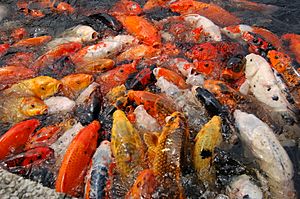
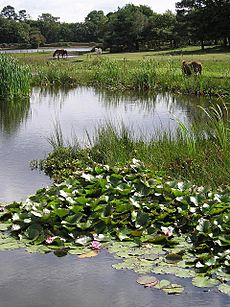
Many people create ponds in their gardens to keep fish. Popular choices are koi and goldfish. Both are strong, colorful fish that don't need special heating. This is true as long as the pond is in an area without extreme temperatures. If you keep fish, you usually need pumps and filters. These devices help keep enough oxygen in the water for the fish to breathe. In cold places, a small heater might be needed in winter. This stops the water from freezing solid.
Here are some common fish for ponds:
- Goldfish (Common, Comet, Shubunkin varieties)
- Koi (Nishikigoi, Butterfly Koi, Ghost Koi)
- Rosy Red minnows
- White Cloud Mountain minnows
- Golden orfe
- Golden tench
Other Animals in Ponds
- Crustaceans: You might find crayfish or freshwater prawns.
- Snails: Small aquatic snails are common, especially where there are plants. Some people buy apple snails for their water gardens.
- Amphibians and Reptiles: Ponds in suburban or rural areas often attract amphibians like Common Frogs and Fire Salamanders. You might also see reptiles such as turtles or snakes.
- Birds: Wild ducks or even Domestic ducks might visit your water garden.
Protecting Your Pond from Predators
Garden ponds can attract animals that might try to eat your fish. In North America, these can include raccoons, herons, snakes, and even pet cats. These predators can be dangerous for fish. Owners of koi, especially, are often very careful to create safe spots for their fish. This is because some koi can be very expensive!
Images for kids
-
Water plants grown in the Yangzhuanghe Canal in Yangzhou, China
See also
 In Spanish: Jardín acuático para niños
In Spanish: Jardín acuático para niños
- List of garden types
- Landscape architecture
- Aquascaping, arranging plants in an aquarium
- Rain garden
- Biotope
- Aquaponics


